Today Current Affairs: 17th March 2022 for UPSC IAS exams, State PSC exams, SSC CGL, State SSC, RRB, Railways, Banking Exam & IBPS, etc
Table of Contents
What Is Project Dolphin?

The MInistry of Jal Shakti expressed his displeasure over the slow pace of the approval process for Project Dolphin.
- Project Dolphin initiative got in-principle approval in 2019 at the first meeting of the National Ganga Council (NGC), headed by the Prime Minister.
- Project Dolphin is one of the activities planned under Arth Ganga, an ambitious inter-ministerial initiative of the government approved in 2019.
- Project Dolphin will be on the lines of Project Tiger, which has helped increase the tiger population.
- It is expected to be implemented by the Ministry of Environment, Forest and Climate Change.
- A Special Conservation program needs to be taken up for Gangetic Dolphin which is a national aquatic animal and also indicator species for the river Ganga spread over several states.
- Indicator species, organisms—often a microorganism or a plant—that serves as a measure of the environmental conditions that exist in a given locale.
- As the Gangetic dolphin is at the top of the food chain, protecting the species and its habitat will ensure conservation of aquatic lives of the river.
- So far, the National Mission for Clean Ganga (NMCG), which implements the government’s flagship scheme Namami Gange, has been taking some initiatives for saving dolphins.
- The Rhine Action Plan (1987) of the International Commission for the Protection of the Rhine (ICPR) — representing Switzerland, France, Germany, Luxemburg and the Netherlands — helped in conservation of the salmon fish (also an indicator species).
PM-DAKSH Scheme:
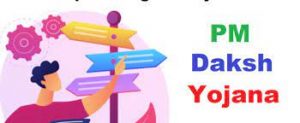
The Ministry of Social Justice & Empowerment has informed the Lok Sabha that the amount of funds earmarked under PM-DAKSH (Pradhan Mantri Dakshta Aur Kushalta Sampann Hitgrahi) Yojana during 2020-21 and 2021-22 are Rs.44.79 crores and Rs.79.48 crores respectively.
- Earlier, the Ministry launched ‘PM-DAKSH’ Portal and ‘PM-DAKSH’ Mobile App to make the skill development schemes accessible to the target groups – SC (Scheduled Caste), OBC (Other Backward Classes), Economically Backward Classes (EBC), Denotified tribes, Sanitation workers.
- It is being implemented from the year 2020-21.
- Under this, eligible target groups are provided with the skill development training programmes on Short Term Training Program; Up-Skilling/Reskilling; Entrepreneurship Development Programme, and Long Term Training Programme.
- These training programmes are being implemented through the government training institutes, sector skill councils that have been constituted by the Ministry of Skill Development and Entrepreneurship, and other credible institutions.
- Marginalised persons of SC, OBC, EBC, Denotified tribes, Sanitation workers including waste pickers, manual scavengers, transgenders and other similar categories.
- It is implemented by the three Corporations under the Ministry:
- National Scheduled Castes Finance and Development Corporation (NSFDC),
- National Backward Classes Finance & Development Corporation (NBCFDC),
- National Safai Karamcharis Finance and Development Corporation (NSKFDC).
Revamped Distribution Sector Scheme:

REC and PFC, the state-run lenders that are the nodal lending agencies for the Rs 3.03 lakh crore revamped distribution sector scheme (RDSS) launched by the Union ministry of power in August last year, will release the first tranche of funds to a host of states including Uttar Pradesh, Assam and Meghalaya by March 31.
- The funds will be disbursed in the form of ad hoc 10% of grant from the central government, while the rest of the disbursal will depend on the discoms concerned fulfilling various conditions under the scheme.
- It is worth Rs. 3.03 trillion scheme wherein the Centre’s share will be Rs. 97,631 crore.
- It aims to improve the operational efficiencies and financial sustainability of discoms (excluding Private Sector DISCOMs).
Highlights of the scheme:
- It is a reforms-based and results-linked scheme.
- It seeks to improve the operational efficiencies and financial sustainability of all DISCOMs/Power Departments excluding Private Sector DISCOMs.
- The scheme envisages the provision of conditional financial assistance to DISCOMs for strengthening supply infrastructure.
- The assistance will be based on meeting pre-qualifying criteria as well as upon the achievement of basic minimum benchmarks by the DISCOM.
- The scheme involves a compulsory smart metering ecosystem across the distribution sector—starting from electricity feeders to the consumer level, including in about 250 million households.
- Scheme also focuses on funding for feeder segregation for unsegregated feeders.
- The Scheme has a major focus on improving electricity supply for the farmers and for providing daytime electricity to them through solarization of agricultural feeders.
- Existing power sector reforms schemes such as Integrated Power Development Scheme, Deen Dayal Upadhyaya Gram Jyoti Yojana, and Pradhan Mantri Sahaj Bijli Har Ghar Yojana will be merged into this umbrella program.
- Each state would have its own action plan for implementation of the scheme rather than a ‘one-size-fits-all’ approach.
- Nodal agencies for the scheme’s implementation are Rural Electrification Corporation (REC) Limited and Power Finance Corporation (PFC).
- The scheme’s cost is borne by the Centre and state governments in a 3:2 ratio. The state governments will be free to borrow from either REC-PFC or from other financial institutions to mobilise the funds.
Periodic Labour Force Survey : NSO
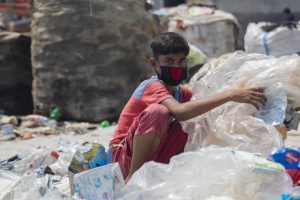
According to the latest Periodic Labour Force Survey (PLFS) released by the National Statistical Office (NSO):
- India’s urban unemployment rate jumped to 12.6 per cent in the April-June quarter of 2021, compared to 9.3 per cent in the January-March quarter.
- It, however, eased from the 20.8 per cent level seen during the first wave of the Covid pandemic.
- The biggest casualty of the pandemic will be joblessness.
- The country’s unemployment rate has risen through much of April, having hit 7.4%, and threatens to climb further to around 8% significantly higher than the 6.5% in March, according to CMIE.
- Approximately 10 million salaried jobs have been lost, across urban and rural India, and one is not sure how many people will get back their livelihoods.
- Urban females fared worse than urban males. In the 15-29 age group, the unemployment rate for urban females stood at 31 per cent compared with 24 per cent for males during April-June 2021.
- The unemployment rate for urban females and males stood at 36 per cent and 34.3 per cent, respectively, in April-June 2020.
New Microfinance Lending Norms: RBI

RBI has released new microfinance lending norms.
As per these norms:
- All entities, banks, non-banking financial companies (NBFCs), and microfinance institutions (MFIs) are subject to the same regulations.
- A microfinance loan is defined by the RBI as a ‘collateral-free’ loan granted to a household with an annual household income of up to Rs 3 lakh.
- All collateral-free loans offered to low-income households, regardless of the end-use and mode of application/processing/disbursal, are considered microfinance loans.
- The financial entities should have a board-approved policy to provide the flexibility of repayment periodicity on microfinance loans as per borrowers’ requirements. They should also have a board-approved policy for the assessment of household income.
- Microfinance is a form of financial service which provides small loans and other financial services to poor and low-income households.
- MFIs are financial companies that provide small loans to people who do not have any access to banking facilities.
- The definition of “small loans” varies between countries. In India, all loans that are below Rs. 1 lakh can be considered as microloans.
What Is Greenhouse Horticulture?
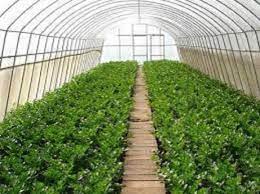
The India Greenhouse Horticulture market held a market value of USD 190.84 Million in 2021 and is estimated to reach USD 271.25 Million by the year 2030.
- The market is expected to register a growth rate of 4.19% over the projected period. In 2021, India’s greenhouse horticulture production was 27.71 million tonnes.
- Greenhouse Horticulture is also known as protected cropping. It is the production of horticultural crops within, under or sheltered by structures for providing modified growing conditions and/or protection from adverse weather, pests, and diseases.
- Growth Influencers:
- Robust increase in population and food demand.
- Rising entrepreneurship under horticulture due to government intervention.
- The term horticulture is derived from two Latin words hortus, meaning ‘garden’, and cultura meaning ‘cultivation’ hence meaning, crops cultivated in a garden cultivation.
- It is a science and art of production, utilisation and improvement of fruits, vegetables, flowers and other plants for human food, non-food uses and social needs.
- L.H. Bailey is considered the Father of American Horticulture and M.H. Marigowda is considered the Father of Indian Horticulture.
Mission for Integrated Development of Horticulture (MIDH):
- Centrally Sponsored Scheme for the holistic growth of the horticulture sector covering fruits, vegetables and other areas.
- Under MIDH, Government of India contributes 60% of the total outlay for developmental programmes in all the states (except North Eastern and Himalayan states where GOI contributes 90%) & 40% is contributed by State governments.
- It has five major schemes on horticulture-
- National Horticulture Mission (NHM)
- Horticulture Mission for North East and Himalayan States (HMNEH)
- National Horticulture Board (NHB)
- Coconut Development Board (CDB) &
- Central Institute of Horticulture (CIH), Nagaland.
National Horticulture Board (NHB):
- It was set up in 1984 on the basis of recommendations of the “Group on Perishable Agricultural Commodities”, headed by Dr M. S. Swaminathan.
- Headquartered at Gurugram.
- Objective is to improve integrated development of Horticulture industry and to help in coordinating, sustaining the production and processing of fruits and vegetables.
What Is AgriStack?
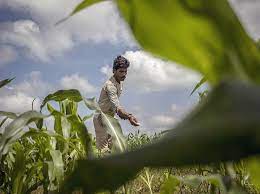
The government is working on a digital ‘stack’ of agricultural datasets, with its core as land records.
- But, such a centralised stack will use old and inaccurate land records; farmers’ personal and financial details will be used without a strong data protection law; and rural areas have a low level of digital literacy. Hence, experts say such an ‘AgriStack’ is problematic.
- The AgriStack is a collection of technologies and digital databases proposed by the Central Government focusing on India’s farmers and the agricultural sector.
- The central government has claimed that these new databases are being built to primarily tackle issues such as poor access to credit and wastage in the agricultural supply chain.
- Under AgriStack’, the government aims to provide ‘required data sets’ of farmers’ personal information to Microsoft to develop a farmer interface for ‘smart and well-organized agriculture’.
- The digital repository will aid precise targeting of subsidies, services and policies, the officials added.
- Under the programme, each farmer of the country will get what is being called an FID, or a farmers’ ID, linked to land records to uniquely identify them. India has 140 million operational farm-land holdings.
A Webinar On Act East Policy:
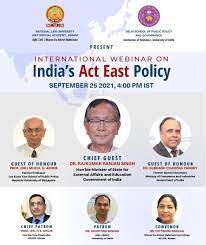
A webinar was recently organised on “Act East Policy”.
- India’s ‘Act East’ policy is a diplomatic initiative to promote economic, strategic and cultural relations with the vast Asia-Pacific region at different levels.
- It is considered as the modern version of the ‘Look East Policy’ which was launched in 1991 by then Prime Minister V. Narasimha Rao.
- The main focus of ‘Look East Policy’ was to shift the country’s trading focus from the west and neighbors to the booming South East Asian countries.
- The “Act East Policy” was launched at the East Asia Summit in Myanmar in November 2014.
- Under the “Act East Policy” the government is relying on the 3 C’s (Culture, Connectivity, and Commerce) to develop better relations with ASEAN nations.
- The focus of the “Look East Policy ” was to increase economic integration with the South East Asian countries and the area was confined to SouthEast Asia only.
- On the other hand the focus of the “Act East Policy” is economic and security integration and the focus area increased to South East Asia as well as East Asia.
Objectives of ‘Act East Policy’:
- Promote economic cooperation, cultural ties, and develop a strategic relationship with countries in the Asia-Pacific region through continuous engagement at regional, bilateral, and multilateral levels.
- To increase the interaction of the North-Eastern Indian states with other neighboring countries.
- To find out the alternatives of the traditional business partners like; more focus on the Pacific countries in addition to the South East Asian countries.
- To curb the increasing impact of China in the ASEAN region.
- Experts say that under the “Act East Policy” the government is relying on the 3 C’s (Culture, Connectivity, and Commerce) to develop better relations with ASEAN nations.
- Under the Act East Policy (AEP), the India-Japan strategic partnership has been lifted to an entirely new level, underscoring the importance of Indo- Pacific cooperation.
- India believes in an Indo-Pacific that is free, open and inclusive, and one that is founded upon a cooperative and collaborative rules-based order.
- ASEAN’s centrality remains the abiding contemporary characteristic of the Indo-Pacific at the regional level.
- India has placed the ‘Indo-Pacific’ at the heart of its engagement with the countries of South, Southeast and East Asia. Gradually, Act ‘East’ is getting transformed into Act ‘Indo-Pacific’.
International Day To Combat Islamophobia:

As the United Nations General Assembly adopted a resolution to proclaim March 15 as the International Day to Combat Islamophobia, India expressed concern over phobia against “one religion being elevated to the level of an international day”.
- India’s Permanent Representative to the UN Ambassador T.S. Tirumurti said in the General Assembly that India hoped the resolution adopted “does not set a precedent”, which will lead to multiple resolutions based on selective religions and divide the United Nations into religious camps.
- Hinduism has more than 1.2 billion followers, Buddhism more than 535 million and Sikhism more than 30 million spread out around the world. It is time that we acknowledged the prevalence of religiophobia, rather than single out just one.
- The 193-member General Assembly adopted a resolution, introduced by Pakistan’s Ambassador Munir Akram under agenda item Culture of peace, to proclaim March 15 as the International Day to Combat Islamophobia.
- Following the adoption of the draft resolution, Mr. Tirumurti said while India condemns all acts motivated by anti-semitism, Christianophobia or Islamophobia, such phobias were not restricted to Abrahamic religions only.
- He pointed to the emergence of anti-Hindu, anti-Buddhist and anti-Sikh phobias.
Chair Of Excellence: General Bipin Rawat

On the eve of the 65th birthday of late Chief of Defence Staff (CDS), General Bipin Rawat, the Indian Army has instituted a Chair of Excellence in his memory at the United Service Institution of India (USI).
- The formal announcement was made by Gen. Manoj Naravane, Chief of Army Staff and Officiating Chairman, Chiefs of Staff Committee, at a ceremony organised at South Block.
- The aim of the proposed Chair of Excellence will be to conduct research on strategic issues of significance pertaining to the armed forces.
- The Chair will be open to veterans of the three Services and civilians having expertise in the field of national security and military affairs.
- Naravane also handed over a cheque for ₹5 lakh to Maj. Gen. B.K. Sharma (retd), Director, USI, which will be paid as honorarium to the nominated Chair of Excellence.
- United Service Institution of India (USI) is a national security and defence services think tank based in New Delhi.
- It was founded in 1870 by a soldier scholar, Colonel (later Major General) Sir Charles MacGregor.
Man-Portable Air-Defence Systems:
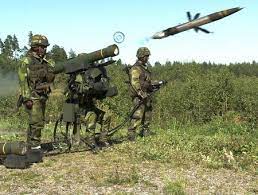
The United States and North Atlantic Treaty Organization (NATO) are shipping weapons into Ukraine, including highly sensitive items such as shoulder-fired missiles called Man-Portable Air-Defence Systems (MANPADS) that can take down aircraft.
- Countries such as India, Pakistan, Germany, UK, Turkey and Israel have also used MANPADS in their defence efforts.
- Russia is by far the biggest exporter of MANPADs, having sold over 10,000 such systems between 2010 and 2018 to various countries including Iraq, Qatar, Kazakhstan, Venezuela, and Libya.
- MANPADS are short-range, lightweight and portable surface-to-air missiles that can be fired by individuals or small groups to destroy aircraft or helicopters.
- They help shield troops from aerial attacks and are most effective in targeting low-flying aircrafts.
- MANPATs or Man-Portable Anti-Tank Systems work in a similar manner but are used to destroy or incapacitate military tanks.
- MANPADS have a maximum range of 8 kilometers and can engage targets at altitudes of 4.5 km.
- The first MANPADS were introduced by the United States and Soviet Union in the 1960s.




